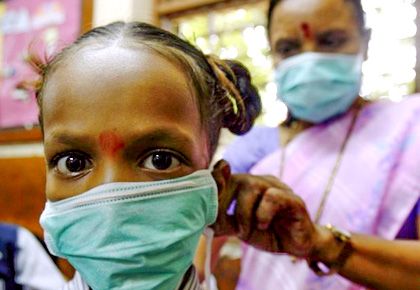The most common signs are fever, cough, sore throat, malaise and headache, vomiting and diarrhoea, says Dr S Chaddha.

After smog, many people in the Delhi/ NCR region are now reporting for another viral illness.
Last week BJP chief Amit Shah was hospitalised for seasonal influenza (H1N1) virus, commonly known as swine flu.
While he is back home and recovering now, there are several others who may not even realise that they are at risk of infection.
What is swine flu?
One of the most prevalent and contagious viruses, H1N1 has three categories -- A, B and C.
While A and B categories need home care, category C requires immediate hospitalisation and medical intervention as its symtpoms and outcomes are extremely severe and could even result in death.
Dr D S Chaddha, director, internal medicine, Fortis Flt. Lt. Rajan Dhall Hospital shares some simple tips to protect and prevent yourself from the H1N1 virus:
Symptoms of swine flu (H1N1)
- The most common signs are fever, cough, sore throat, malaise and headache, vomiting and diarrhoea.
- In children, young children are less likely to have the usual influenza signs and symptoms such as fever and cough.
- Infants may have fever and lethargy, cough or other respiratory symptoms.
- Symptoms of severe disease in infants and young children may include apnea, tachypnea, dyspnea, cyanosis, dehydration, altered mental status and extreme irritability.
Who is at risk?
If you are pregnant or obese you are at higher risk of swine flu.
Check out if you fall in the high risk category.
High risk groups include:
- Children younger than five years old
- Adults who are 65 years and above
- Patients who have a chronic pulmonary condition (including asthma)
- Patients who have a cardiovascular (except hypertension), renal, hepatic, hematological (including sickle cell disease), neurologic, neuromuscular or metabolic disorder (including diabetes mellitus)
- Patients who are on immune suppressants
- Patients of HIV
- Pregnant women
- Obese adults
- Residents of nursing homes and other chronic-care facilities
If you test positive for the above mentioned symptoms, you may consult your doctor and also seek treatment from home.
Home care treatment for influenza A and B (H1N1)
- Check with your health care provider about any special care that might be needed if the patient is pregnant or has a health condition such as diabetes, heart disease, asthma or emphysema
- Check with with your doctor if the patient should take antiviral medications
- Keep the patient away from other people as much as possible. They should not be going to school or work.
- Watch out for primary influenza symptoms: high temperature, runny nose, cough, headache, muscle and joint pain
- The patient should stay at home for at least 24 hours after the fever subsides.
- To prevent dehydration, the patient should rest and drink plenty of fluids such as water, broth, sports drinks and electrolyte beverages.
- Coughs and sneezes should be covered. Hands should be cleaned using soap and water or an alcohol based hand rub.
- A face mask should be worn at all times to prevent the virus from spreading to near and dear ones.











